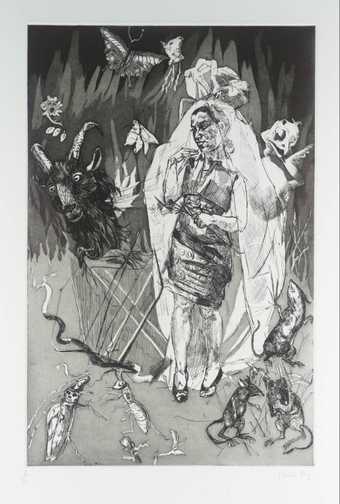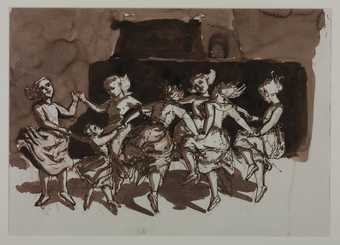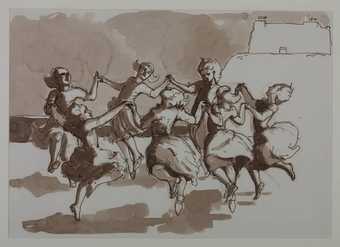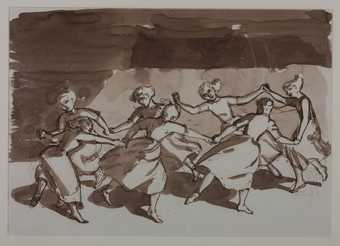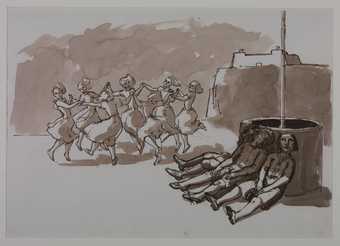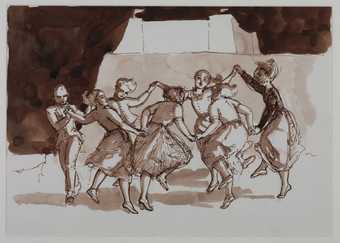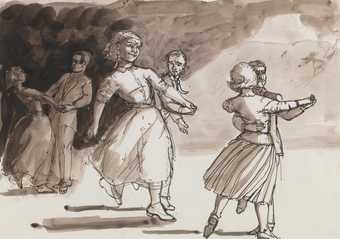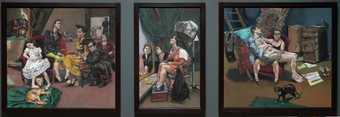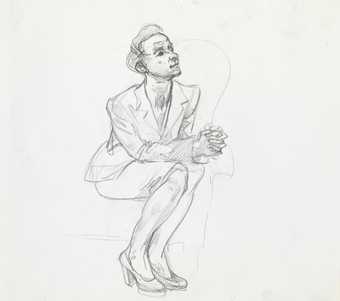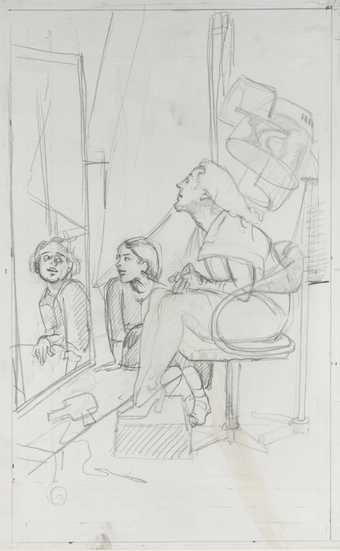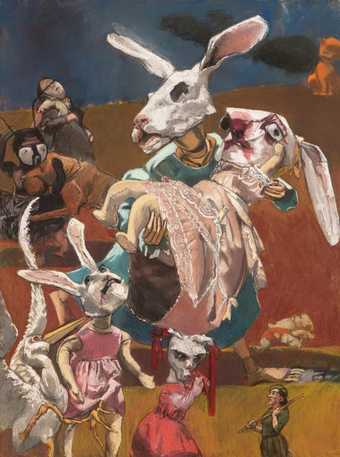
Not on display
- Artist
- Paula Rego 1935 – 2022
- Medium
- Pastel on paper on aluminium
- Dimensions
- Support: 1200 × 1606 mm
frame: 1350 × 1750 × 75 mm
packed (TF): 1535 × 1935 × 160 mm - Collection
- Tate
- Acquisition
- Purchased 1995
- Reference
- T06959
Summary
Bride is one of a series of large-scale works in pastel Rego made in 1994 which she called the Dog Women. She had previously worked mainly with oil paint, acrylics and watercolour, but discovered that working with pastel on paper, backed with canvas and laminated onto a sheet of aluminium for support, allowed her a liberating spontaneity. ‘With pastel you don’t have the brush between you and the surface. Your hand is making the picture. It’s almost like being a sculptor … It’s very tactile.’ (Rego quoted in McEwen, p.215). Most of the works in this series depict a single monumental woman in a variety of animal-like poses in which she is simultaneously submissive and fiercely independent.
To be a dog woman is not necessarily to be downtrodden; that has very little to do with it. In these pictures every woman’s a dog woman, not downtrodden but powerful. To be bestial is good. It’s physical … To picture a woman as a dog is utterly believable. It emphasises the physical side of her being. What is important is that the dog is the animal most like a human. A dog learns people’s ways and behaves like a person, just as people do. Women learn from those they are with; they are trained to do certain things, but they are also part animal. They have independence of body, independence of spirit and their tastes can be quite gross.
(Quoted in McEwen, p.216.)
Although Rego had used Lila Nunes, the woman who had nursed her husband, the painter Victor Willing (1928-88), and then her mother, as the model for most of the dog women, she used her daughter Victoria Willing as the model for Bride and a related work of the same year, Moth (private collection). The images using Nunes are characterised by her powerful physicality and depict ferocity mixed with devotion. Bride and Moth portray less aggressive emotional states. Moth was inspired by an erotic poem of the same name by Blake Morrison (born 1950), which for the artist ‘opened up a whole can of worms’ about marriage (McEwen, p.223). The woman it portrays, who is wearing a cocktail dress belonging to Rego’s mother, sits sideways over a chair with her head cocked and her arms up as if obedient and receptive to an approaching husband. In Bride the mood is even more passive, as the subject reclines awkwardly, presumably after the wedding ceremony. With her legs bent at the knee, slightly apart, and her feet carefully placed on the ground, she seems to be waiting for her groom, but without the sense of joy or exhilaration one might expect on such an occasion. Looking directly out of the painting, she appears both loving and resigned, in a position of ambiguous isolation.
Further reading:
John McEwen, Paula Rego, London 1997, pp.211-23, reproduced p.219 (colour)
Judith Collins, Ruth Rosengarten, Victor Willing, Paula Rego, exhibition catalogue, Tate Gallery Liverpool 1997, pp.88-101, reproduced p.93 (colour)
Paula Rego: Dog Woman, exhibition catalogue, Marlborough Fine Art, London 1994
Elizabeth Manchester
June 2000
Does this text contain inaccurate information or language that you feel we should improve or change? We would like to hear from you.
Display caption
Bride is one of a series of pastels which Rego made in 1994 and which were shown that year under the title 'Dog Woman'. The pastels depicted women in dog-like positions, scavenging for food, baying at the moon, sleeping and grooming. Rego's daughter posed for this work wearing a 1950's raw silk wedding dress loaned by a friend. An early idea for 'Bride' had the model sitting on all fours, but Rego turned the figure so that she is 'belly-up in an attitude of surrender and ready to have her tummy tickled'. Rego has also noted that 'her hands and feet are uncovered, it was so vital that her extremities were exposed as they are in all animals'.
Gallery label, May 1995
Does this text contain inaccurate information or language that you feel we should improve or change? We would like to hear from you.
Explore
- emotions, concepts and ideas(16,416)
-
- emotions and human qualities(5,345)
-
- contemplation(141)
- vulnerability(311)
- universal concepts(6,387)
-
- irony(304)
- actions: postures and motions(9,111)
-
- reclining(814)
- woman(9,110)
- individuals: female(1,698)
- dress: ceremonial/royal(104)
-
- wedding dress(24)
- marriage(392)
You might like
-
Paula Rego Straw Burning
1996 -
Paula Rego Drawing for ‘The Dance’
1988 -
Paula Rego Drawing for ‘The Dance’
1988 -
Paula Rego Drawing for ‘The Dance’
1988 -
Paula Rego Drawing for ‘The Dance’
1988 -
Paula Rego Drawing for ‘The Dance’
1988 -
Paula Rego Drawing for ‘The Dance’
1988 -
Paula Rego Drawing for ‘The Dance’
1988 -
Paula Rego Drawing for ‘The Dance’
1988 -
Paula Rego Drawing for ‘The Dance’
1988 -
Paula Rego Study for the Girl’s Mother in ‘Betrothal’ I
1999 -
Paula Rego Study for the Girl’s Mother in ‘Betrothal’ II
1999 -
Paula Rego Study for ‘Lessons’ II
1999 -
Paula Rego War
2003

